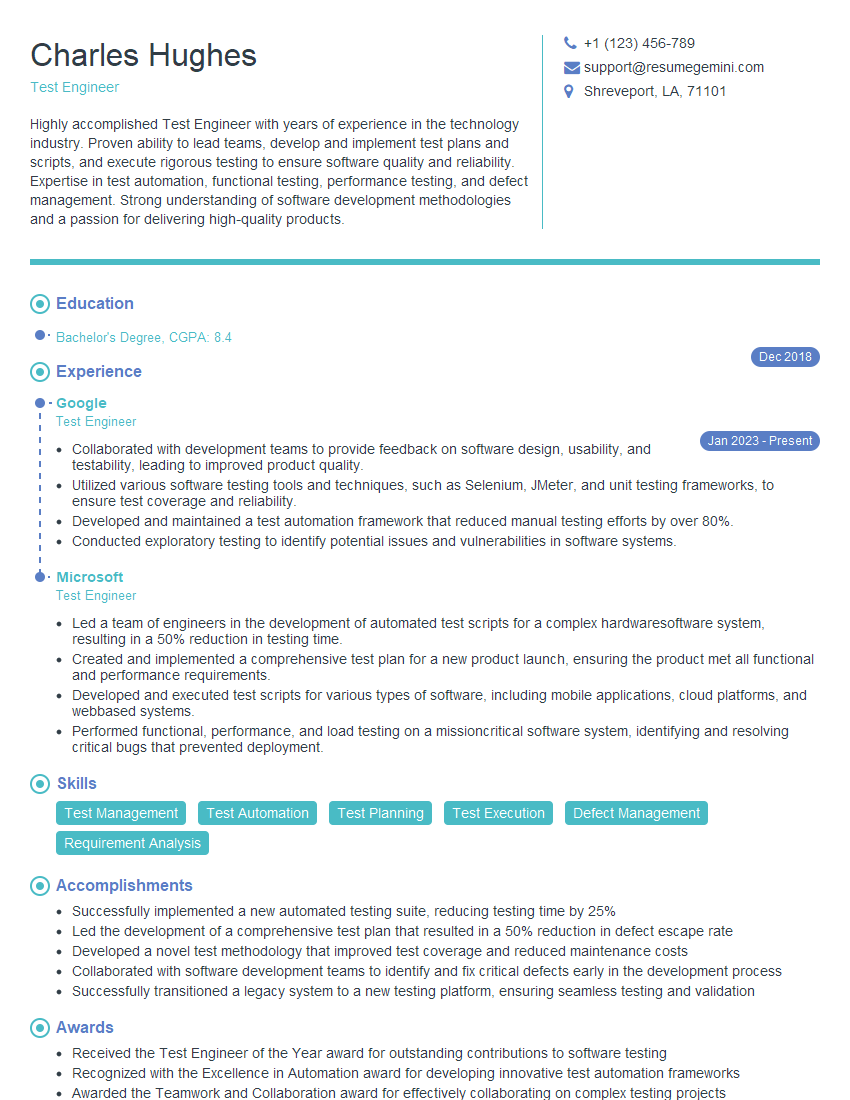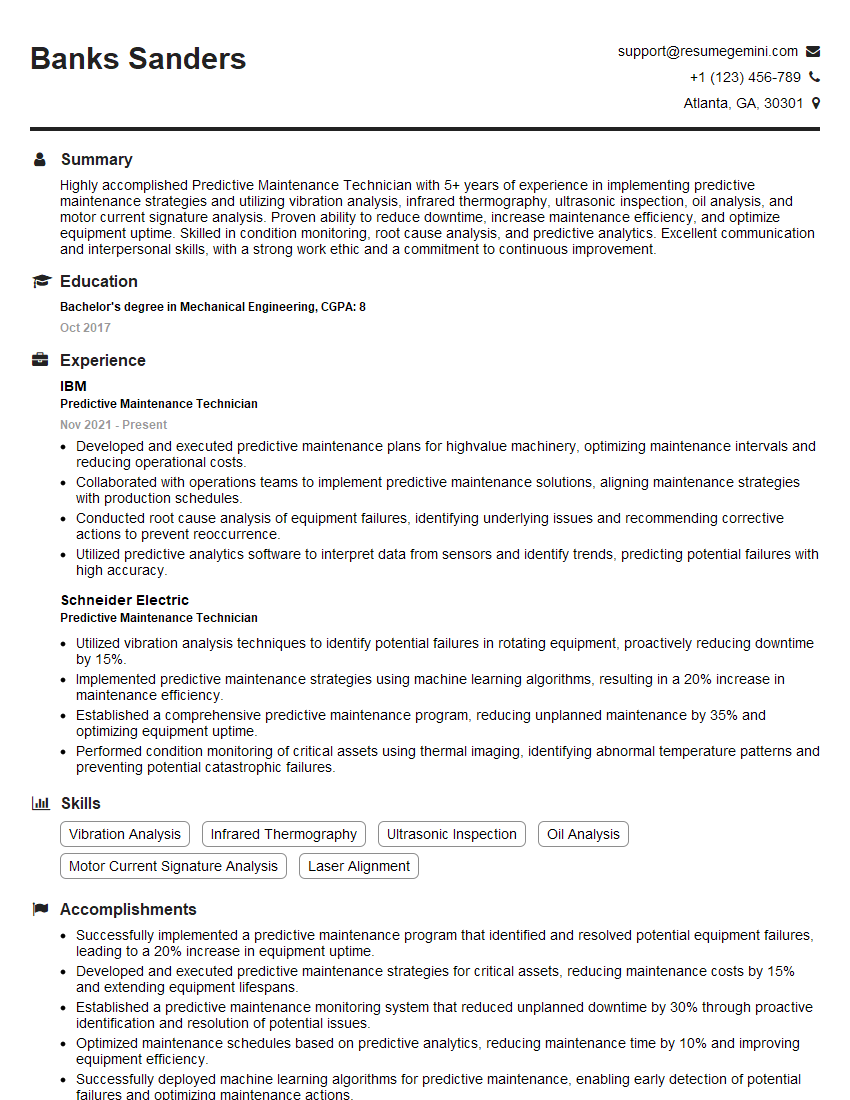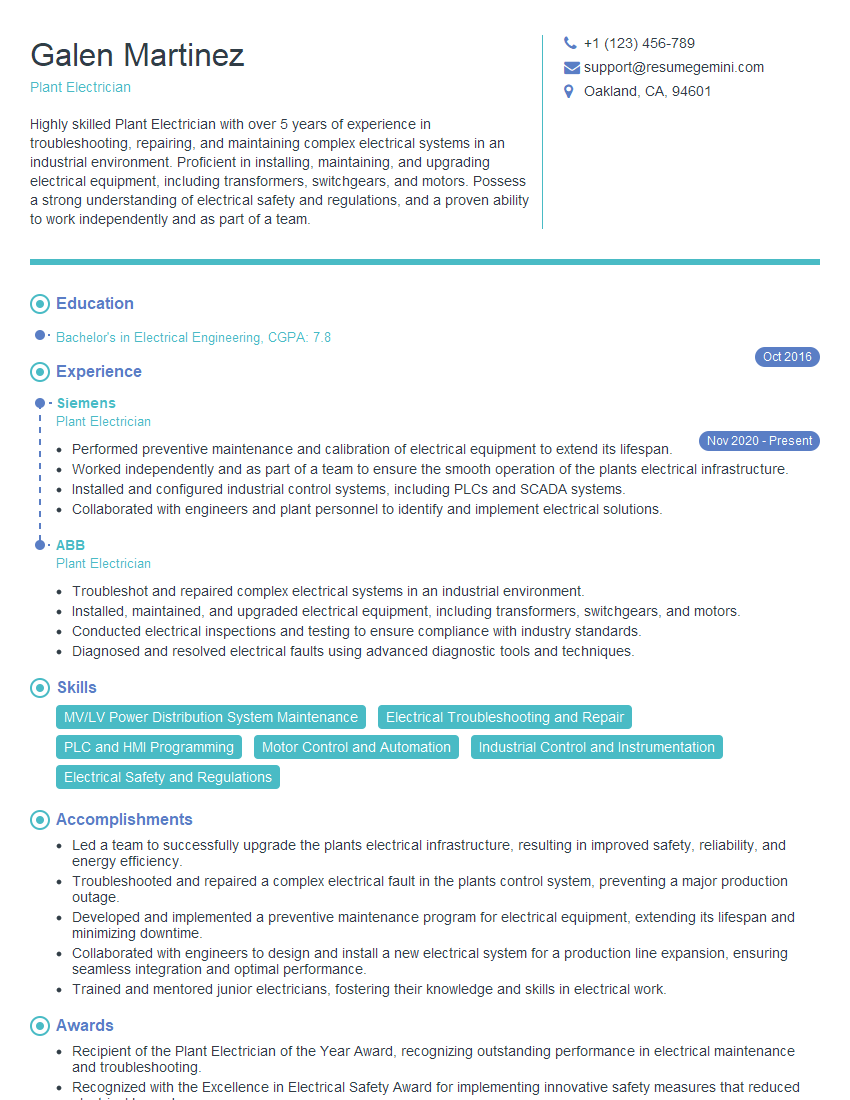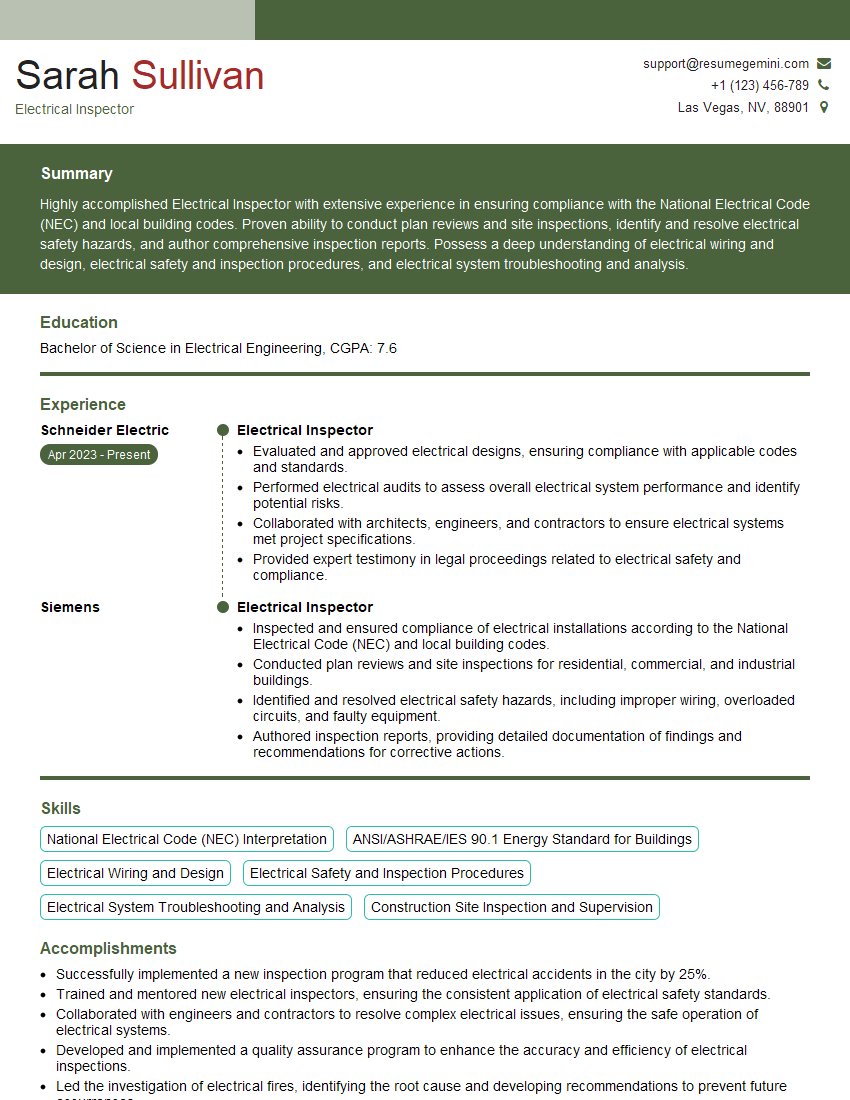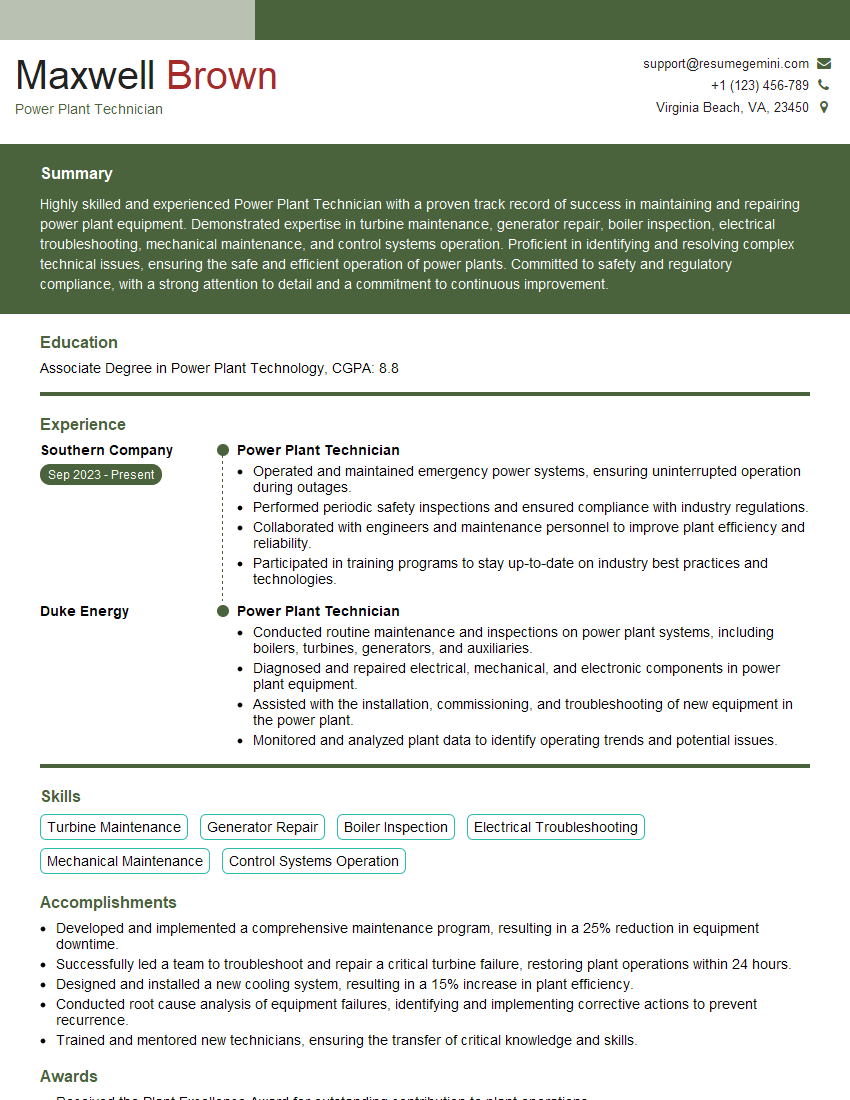Feeling uncertain about what to expect in your upcoming interview? We’ve got you covered! This blog highlights the most important Insulation Testing interview questions and provides actionable advice to help you stand out as the ideal candidate. Let’s pave the way for your success.
Questions Asked in Insulation Testing Interview
Q 1. Explain the purpose of insulation testing.
Insulation testing is crucial for ensuring the safety and reliability of electrical equipment. Its primary purpose is to verify the integrity of the insulating material that separates electrically charged components. This prevents dangerous short circuits, electric shocks, and equipment failure. Think of it like checking the insulation on a house – you want to make sure the wiring is properly protected to prevent fires. A thorough insulation test helps identify weaknesses in the insulation before they lead to catastrophic consequences.
Q 2. What are the different types of insulation testing methods?
Several methods exist for testing insulation, each suited to different applications and equipment. Common types include:
- Dielectric Strength Test: This measures the insulation’s ability to withstand high voltages before breakdown. It’s like testing the strength of a dam – you want to see how much pressure it can take before it breaks.
- Insulation Resistance Test (Megger Test): This measures the resistance to the flow of current through the insulation. A high resistance indicates good insulation, while low resistance suggests a potential problem.
- Polarization Index (PI) Test: This assesses the insulation’s absorption and polarization characteristics, providing insights into its condition and potential degradation.
- Tan Delta Test: This measures the dielectric losses in the insulation, helping detect defects that might not be apparent in other tests.
- Partial Discharge Test: This detects partial discharges within the insulation, which are early indicators of insulation failure.
The choice of test depends on factors such as the type of equipment, its voltage rating, and the level of detail required.
Q 3. Describe the process of performing a dielectric strength test.
A dielectric strength test involves applying a gradually increasing AC or DC voltage to the insulation until it breaks down. The process typically includes:
- Preparation: The equipment is prepared by disconnecting it from the power source and ensuring proper grounding.
- Connection: The high-voltage test equipment is connected to the insulation. Proper connection is essential for accurate results.
- Voltage Application: The voltage is gradually increased at a controlled rate, usually according to a predefined standard.
- Breakdown Voltage Measurement: The voltage at which the insulation fails (breaks down) is recorded. This is the dielectric strength of the insulation.
- Post-Test Inspection: After the test, the insulation is inspected for visible damage.
For example, in testing a high-voltage cable, we’d gradually increase the voltage until a spark occurs or a sudden drop in current is observed, indicating insulation breakdown. The voltage at this point is the cable’s dielectric strength. The test provides a critical evaluation of the cable’s ability to withstand high voltages in normal operation.
Q 4. Explain the concept of insulation resistance and its significance.
Insulation resistance is a measure of how well an insulating material resists the flow of electrical current. It’s expressed in ohms (Ω) or megohms (MΩ). A high insulation resistance indicates good insulating properties, signifying minimal leakage current. This is vital for safety and reliability because it prevents current from flowing where it shouldn’t, thus preventing short circuits, equipment damage, and electrical hazards. Think of it like a dam holding back water – high resistance is like a strong dam preventing water leakage, while low resistance is like a weak dam letting water seep through.
Q 5. How do you interpret insulation resistance test results?
Insulation resistance test results are compared against acceptance criteria specified in standards or manufacturer’s recommendations. A high insulation resistance value typically indicates good insulation condition. However, a low value may indicate:
- Moisture ingress: Moisture reduces the resistance of insulation.
- Contamination: Dirt or other contaminants can lower resistance.
- Insulation degradation: Age, heat, or chemical exposure can degrade insulation.
- Physical damage: Cracks or punctures in the insulation.
The interpretation also considers the equipment’s age, operating conditions, and the specific test method used. A trend analysis of readings over time can be more informative than a single measurement.
Q 6. What factors affect insulation resistance?
Several factors influence insulation resistance. These include:
- Temperature: Higher temperatures generally lower insulation resistance.
- Moisture: Moisture significantly reduces insulation resistance, acting as a conductor.
- Age: Insulation degrades with age, leading to reduced resistance.
- Material: Different insulating materials possess different resistance properties.
- Voltage: The applied voltage can influence the measured resistance, especially with polarizing materials.
- Contamination: Dust, dirt, and other contaminants can create conductive paths.
Understanding these factors is critical for accurately interpreting test results. For instance, a slightly lower resistance reading during a humid day might not indicate a problem, while a consistently low resistance might suggest degradation requiring further investigation.
Q 7. What are the safety precautions involved in insulation testing?
Insulation testing involves high voltages and can be dangerous if not performed correctly. Key safety precautions include:
- Lockout/Tagout: Ensure the equipment is completely de-energized and locked out before testing.
- Grounding: Properly ground the equipment and the test equipment to prevent electrical shocks.
- Personal Protective Equipment (PPE): Wear appropriate PPE, including insulated gloves, safety glasses, and safety shoes.
- Trained Personnel: Only qualified and trained personnel should perform insulation testing.
- Safe Working Procedures: Follow established safety procedures and guidelines.
- Emergency Procedures: Have an emergency plan in place in case of an accident.
Neglecting these precautions can lead to serious injury or even death. Safety should always be the top priority during insulation testing.
Q 8. What is polarization index (PI) and what does it indicate?
The Polarization Index (PI) is a crucial indicator of the condition of electrical insulation. It’s calculated during a DC insulation resistance test by taking the ratio of the insulation resistance measured at 10 minutes to the insulation resistance measured at 1 minute. Essentially, it reveals how well the insulation material absorbs and releases electrical charges.
A high PI (typically above 2) suggests good insulation health, indicating that the insulation is able to absorb and hold the charge without significant leakage. This points to a healthy dielectric material with minimal degradation. Conversely, a low PI (below 1.5) indicates potential problems, such as moisture absorption, insulation breakdown, or contamination. For instance, if you’re testing the insulation of a motor winding and get a low PI, it flags a potential problem needing further investigation. It suggests the insulation is absorbing charge more slowly than expected which implies damage to the structure.
Q 9. What is dielectric absorption ratio (DAR) and how is it used?
The Dielectric Absorption Ratio (DAR), similar to PI, is derived from a DC insulation resistance test, but provides a slightly different perspective. It’s the ratio of the insulation resistance measured at 60 seconds to that measured at 15 seconds. It essentially assesses how quickly the insulation absorbs charge. A higher DAR indicates a healthier dielectric material with lesser degradation.
Think of it like a sponge: a new, dry sponge absorbs water rapidly (low DAR), while an old, waterlogged sponge absorbs water much more slowly (high DAR). In insulation testing, a low DAR often points towards good insulation health, while a high DAR could signify moisture absorption or contamination. For example, during preventative maintenance on a high-voltage transformer, a high DAR might prompt a more thorough investigation into the condition of the transformer oil and insulation.
Q 10. How do you troubleshoot high insulation resistance readings?
High insulation resistance readings, while seemingly positive, can also be misleading. They don’t always represent a perfectly healthy system. In fact, this result often indicates an issue with the test setup itself rather than perfect insulation.
Troubleshooting begins with verifying the test equipment: Ensure proper calibration and that the test leads are clean and firmly connected. Next, consider the test voltage: Too high a voltage could lead to inaccurate readings. Check for any stray capacitance or leakage paths in the testing circuit, like moisture in connectors or near the equipment under test. Lastly, ensure the test environment is dry; moisture can significantly impact readings. A methodical approach, starting with the simplest checks, will often identify the problem before delving into more complex issues.
Q 11. How do you troubleshoot low insulation resistance readings?
Low insulation resistance readings are a clear indication of a problem within the insulation system. The first step is to visually inspect the equipment for any obvious signs of damage, such as cracks, burns, or physical degradation. Moisture is a common culprit—inspect for signs of water ingress, and check the environment for humidity.
Next, look at the insulation itself. Over time, insulation materials degrade, their chemical structure changes, leading to lower resistance. Contamination, such as dust or conducting particles, can also lower insulation resistance. For instance, a motor with a low insulation resistance might indicate that the windings have been contaminated by metallic debris or have suffered from excessive heat. It could also be failing due to insulation breakdown. Specific tests might be needed to pinpoint the precise cause, but a thorough visual and environmental investigation should narrow down the possibilities.
Q 12. Explain the difference between AC and DC insulation testing.
AC and DC insulation testing serve different purposes and provide different insights. DC testing, primarily used for measuring insulation resistance, applies a constant DC voltage and measures the leakage current. This test is effective at detecting moisture and low-resistance paths caused by contaminants. The PI and DAR are calculated from a DC test.
AC testing, on the other hand, uses an alternating current voltage to measure dielectric strength. This test is important for determining the insulation’s ability to withstand high voltages and identifies insulation breakdown or weakening. AC testing is particularly important for high-voltage equipment.
In essence, DC testing focuses on the resistance to steady leakage current and provides indicators of overall insulation integrity, while AC testing focuses on the ability of the insulation to withstand high voltage stresses and pinpoint areas of weakness or breakdown.
Q 13. What are the limitations of insulation testing?
Insulation testing, while valuable, has limitations. Firstly, it’s a non-destructive test; however, results might not reveal all potential problems. A high insulation resistance doesn’t guarantee perfect insulation; microscopic defects or impending failures might remain undetected. Additionally, the test only indicates the current state of the insulation at the time of the test. It does not predict future degradation or failure.
Environmental factors can significantly affect test results. Temperature and humidity can influence the readings. Furthermore, insulation testing only assesses the insulation system; it may not provide insights into other parts of the equipment. This is why a comprehensive maintenance program combines insulation testing with other diagnostic techniques.
Q 14. What are the common causes of insulation failure?
Insulation failure can stem from several causes, often interconnected. Ageing is a major contributor; insulation materials degrade over time, leading to reduced resistance. Moisture is another significant factor, lowering insulation resistance and facilitating electrical breakdown. Heat, exceeding the insulation’s thermal limits, causes degradation and may lead to charring or melting.
Mechanical stress, such as vibrations or pressure, can damage insulation. Contamination, with conductive materials such as dust or metallic particles, lowers the insulation resistance and introduces leakage paths. Lastly, overvoltage stresses can weaken or puncture insulation. Understanding these potential causes is crucial for preventative maintenance and avoiding costly equipment failures.
Q 15. How do you select the appropriate insulation test voltage?
Selecting the appropriate insulation test voltage is crucial for accurate and safe testing. It’s not a one-size-fits-all approach; the correct voltage depends on several factors, primarily the rated voltage of the equipment being tested and the insulation’s expected characteristics. Think of it like this: you wouldn’t test a small flashlight battery with the same voltage as a car battery – you risk damage!
Generally, the test voltage should be significantly higher than the equipment’s operating voltage to effectively stress the insulation and reveal weaknesses. Standards and manufacturers’ recommendations often provide guidance. For example, a common practice is to use a test voltage of 1000V for equipment with a rated voltage of 600V. However, a higher test voltage might be necessary for higher-voltage equipment or critical applications requiring a higher safety margin. Always consult relevant standards (like IEEE, IEC) and manufacturer’s specifications for precise guidance.
For instance, testing a 120V motor might involve using a 1000V test voltage. A high-voltage cable designed for 15kV may require a 50kV insulation test. The key is to apply sufficient voltage to reveal any weaknesses but not so high as to cause unnecessary damage to the insulation.
Career Expert Tips:
- Ace those interviews! Prepare effectively by reviewing the Top 50 Most Common Interview Questions on ResumeGemini.
- Navigate your job search with confidence! Explore a wide range of Career Tips on ResumeGemini. Learn about common challenges and recommendations to overcome them.
- Craft the perfect resume! Master the Art of Resume Writing with ResumeGemini’s guide. Showcase your unique qualifications and achievements effectively.
- Don’t miss out on holiday savings! Build your dream resume with ResumeGemini’s ATS optimized templates.
Q 16. Explain the importance of proper grounding during insulation testing.
Proper grounding during insulation testing is paramount for safety and accurate results. Grounding ensures that any leakage current during the test flows safely to the earth, preventing electric shock to the operator and avoiding erroneous readings. Imagine testing a device with poor insulation – without grounding, the leakage current could flow through the operator, causing a dangerous shock. Grounding provides a low-resistance path for this current, minimizing this risk.
Furthermore, a good ground connection ensures that the test voltage is applied consistently to the insulation. Poor grounding could result in a voltage drop, leading to inaccurate measurement of insulation resistance. Think of it as creating a stable and controlled environment for the test. Always use a properly sized and connected ground lead to a known good earth ground. The quality of the ground connection is as important as the test equipment itself for reliable and safe testing.
Q 17. What is the purpose of a megger?
A megger, also known as an insulation resistance tester, is a device used to measure the insulation resistance of electrical equipment. It’s essentially an ohmmeter designed to measure very high resistances, typically in megaohms (MΩ). Its purpose is to determine the quality of insulation in electrical systems, identifying potential weaknesses or deterioration before they lead to failure. This prevents costly downtime, potential hazards, and safety risks.
Think of it as a doctor’s checkup for your electrical system. A low insulation resistance reading could indicate moisture, contamination, or damage to the insulation, warning of potential short circuits or electrical hazards. Regular megger testing helps to prevent unexpected equipment failures and ensures the safety of personnel and equipment.
Q 18. Describe the different types of meggers.
Meggers come in various types, primarily categorized by their voltage and functionality. Some common types include:
- Hand-crank meggers: These are portable and self-powered, using a hand crank to generate the test voltage. They are simple and reliable but require manual operation.
- Electronic meggers: These are battery-powered or mains-powered devices that provide more accurate and consistent measurements than hand-crank meggers. They often feature a wider range of test voltages and more advanced features.
- Digital meggers: These offer digital displays, providing precise readings and often incorporating data logging capabilities for easier record-keeping.
- Micro-ohmmeters: These specialized meggers are used for measuring very low resistances, often used in testing low-resistance windings or connections.
The choice of megger depends on the application, required test voltage, desired accuracy, and budget. For instance, hand-crank meggers are suitable for basic testing in smaller installations, while digital electronic meggers are preferred for precise measurements in critical applications.
Q 19. How do you maintain and calibrate a megger?
Maintaining and calibrating a megger is essential for ensuring accurate and reliable measurements. Proper maintenance involves:
- Regular cleaning: Keeping the megger clean and free from dust and debris helps prevent internal damage and ensures proper functionality.
- Storage: Store the megger in a dry, clean environment to prevent moisture damage and maintain the accuracy of the measurements.
- Handling: Avoid dropping or subjecting the megger to harsh conditions that might damage the internal components.
Calibration is crucial to maintaining accuracy. Meggers should be calibrated regularly (typically annually or as per manufacturer’s recommendations) by a qualified calibration laboratory. Calibration ensures the megger readings are within acceptable tolerances and traceable to national standards. Calibration reports should be maintained as part of the megger’s records. Improper calibration could lead to inaccurate test results with significant safety implications.
Q 20. What is the difference between a megger and a hipot tester?
While both meggers and hipot testers (high-potential testers) are used for insulation testing, they differ in their applications and the type of tests they perform. A megger measures the insulation resistance – a DC measurement showing the resistance to the flow of a direct current. The result is given in megaohms (MΩ).
A hipot tester, on the other hand, applies a high AC or DC voltage to the insulation to stress it and find potential weaknesses. It does not directly measure the resistance but rather detects the presence or absence of breakdown at a particular voltage. Hipot testing is often used to test for potential breakdown under high stress conditions, while a megger provides a more continuous assessment of the insulation’s overall condition.
Think of it this way: a megger is like a regular health check-up showing overall health, while a hipot test is like a stress test, pushing the insulation to its limits to detect any immediate issues.
Q 21. Explain the concept of breakdown voltage.
Breakdown voltage refers to the minimum voltage at which an insulator fails and allows current to flow. It’s the point at which the insulation’s dielectric strength is overcome. Imagine a dam holding back water. The water pressure represents the voltage, and the dam represents the insulation. If the water pressure (voltage) exceeds the dam’s strength, the dam (insulation) will break, and water (current) will flow.
This is a crucial parameter in insulation testing. The breakdown voltage is determined by factors such as the material’s properties (dielectric strength), thickness, temperature, and environmental conditions. Knowing the breakdown voltage of an insulator allows engineers to select appropriate operating voltages and safety factors to ensure the insulation doesn’t fail under normal operating conditions. Testing is performed to ensure the insulation is capable of withstanding a much higher voltage than its expected operating voltage, providing a safety margin.
Q 22. What are the different types of insulation materials and their properties?
Insulation materials are broadly categorized based on their chemical composition and physical properties. Each type offers a unique set of advantages and disadvantages making them suitable for specific applications.
- Solid Insulation: This includes materials like rubber, plastics (e.g., polyethylene, PVC), porcelain, and various types of resins. These materials provide good dielectric strength, meaning they can withstand high voltages without breaking down. Their properties vary greatly depending on the specific material. For example, polyethylene exhibits excellent high-frequency performance, while porcelain is highly resistant to environmental degradation.
- Liquid Insulation: Transformer oil and other dielectric fluids are examples. They offer good heat dissipation capabilities, crucial in high-power applications. The dielectric strength of liquid insulation can be affected by contamination, moisture, and temperature.
- Gaseous Insulation: Gases like sulfur hexafluoride (SF6) and air are used as insulators. SF6 has exceptionally high dielectric strength and is often used in high-voltage switchgear. Air, while readily available, has a significantly lower dielectric strength.
- Composite Insulation: These materials combine different insulation types, like a solid material impregnated with a liquid or gas, to achieve a balance of properties. For instance, a paper-oil composite is frequently found in power transformers.
The selection of an insulation material depends on factors like the operating voltage, temperature, environmental conditions, and the desired lifespan of the equipment.
Q 23. How do you interpret a tan delta test result?
The tan delta test, also known as the dissipation factor test, measures the power loss in an insulator due to dielectric losses. The result, expressed as a tangent (tan) of the loss angle (delta), indicates the insulation’s condition. A lower tan delta value suggests better insulation quality, indicating minimal dielectric losses.
Interpretation:
- Low tan delta (typically below 0.1%): Indicates good insulation health and minimal dielectric losses. The material is effectively resisting the flow of current.
- Moderate tan delta (0.1% to 1%): Suggests potential problems like partial discharges, aging, or moisture ingress. Further investigation might be required.
- High tan delta (above 1%): Indicates significant insulation degradation, possibly due to severe aging, contamination, or damage. Immediate action is necessary, as the insulation is likely nearing failure.
It’s crucial to consider the acceptable tan delta value based on the specific material and application. Manufacturers’ specifications often provide guidance on acceptable limits.
Q 24. What are the effects of moisture on insulation resistance?
Moisture significantly reduces the insulation resistance of most materials. Water is a conductor; when it penetrates insulation, it creates conductive paths, lowering the overall resistance and increasing leakage current. This can lead to overheating, partial discharges, and ultimately, insulation failure.
The impact of moisture depends on the type of insulation material and its structure. For example, porous materials like paper or wood are more susceptible to moisture absorption than denser materials like certain plastics. Increased humidity and temperature accelerate moisture penetration.
In practical terms, a cable with moisture ingress will show a significantly lower insulation resistance value compared to a dry cable. This reduction can be dramatic, potentially leading to a dangerous situation if the insulation resistance drops below safety thresholds.
Q 25. How do you prepare a test report for insulation testing?
A comprehensive insulation test report should include all relevant information about the testing procedure and results. This ensures transparency and traceability. A typical report structure would include:
- Test Date and Time: Records when the test was performed.
- Equipment Details: Megger model number and calibration details.
- Test Parameters: Voltage applied, test duration, and temperature.
- Equipment Identification: Clear identification of the tested equipment (e.g., motor nameplate details, cable markings).
- Test Results: Insulation resistance values (in megaohms), tan delta values (if measured), and any other relevant parameters. Include graphs or tables where applicable.
- Pass/Fail Criteria: Clearly state the acceptance criteria and whether the equipment passed or failed the test.
- Technician Signature and Qualifications: Verification of the test’s integrity.
- Observations and Recommendations: Note any anomalies observed during testing and suggestions for future maintenance.
A well-documented report is vital for tracking equipment health, ensuring safety, and meeting regulatory requirements.
Q 26. Describe your experience with different types of insulation testing equipment.
My experience spans various insulation testing equipment, including:
- Megger Insulation Testers: I’ve extensively used various models from Megger, including both digital and analog types. These are industry standards and offer accurate measurements across a wide range of voltages.
- High-Voltage Testers: I’m familiar with using high-voltage testers for testing high-voltage equipment like transformers and power cables. Safety is paramount during these tests, requiring adherence to strict safety protocols.
- Tan Delta Testers: I have experience performing tan delta tests using specialized equipment to measure dielectric losses, which provide valuable insights into insulation condition.
- Partial Discharge Detectors: I’ve utilized partial discharge detection equipment to identify and locate partial discharges within insulation systems, allowing for early detection of potential problems.
My experience covers both portable, field-based equipment, and larger, laboratory-grade testing systems. I’m proficient in operating, maintaining, and interpreting data from a variety of equipment types.
Q 27. How do you ensure the accuracy and reliability of your insulation testing results?
Ensuring accurate and reliable insulation testing results relies on a multi-faceted approach:
- Proper Calibration: Regular calibration of all testing equipment against traceable standards is essential. This ensures that the equipment is functioning accurately.
- Standard Operating Procedures: Adhering to established procedures ensures consistency and minimizes human error. This includes proper connection techniques, voltage application, and data recording.
- Environmental Considerations: Environmental factors like temperature and humidity can influence results. These factors must be controlled or accounted for during testing and reported.
- Data Validation: Results should be carefully reviewed for anomalies. Outliers should be investigated and potentially re-tested to confirm validity.
- Experienced Personnel: Testing should be performed by qualified personnel who understand the limitations of the equipment and the interpretation of results.
A combination of these steps ensures the integrity of the testing process and leads to reliable and trustworthy results.
Q 28. Describe a challenging insulation testing situation you encountered and how you resolved it.
I once encountered a situation where a large industrial motor showed unexpectedly low insulation resistance values during routine testing. Initial investigations, including visual inspections, revealed no obvious signs of damage.
The challenge was to pinpoint the cause of the low readings without dismantling the motor, which would have been costly and time-consuming. I systematically investigated potential causes, including:
- Moisture ingress: We carefully inspected the motor for any signs of moisture intrusion, but found none.
- Contamination: A thorough visual inspection ruled out any visible contaminants.
- Winding Degradation: This was suspected as a likely cause. To investigate further, I performed a detailed insulation resistance test at various temperatures and using different test voltages.
The results revealed a gradual reduction in insulation resistance with increasing temperature, strongly suggesting winding degradation. This was confirmed by subsequent advanced diagnostics using a partial discharge detection system. This allowed us to recommend targeted repairs rather than a complete motor replacement, saving significant costs and downtime.
Key Topics to Learn for Insulation Testing Interview
- Dielectric Strength & Breakdown Voltage: Understand the fundamental principles behind dielectric strength and how it relates to insulation materials. Be prepared to discuss factors influencing breakdown voltage and methods for measuring it.
- Insulation Resistance Measurement Techniques: Familiarize yourself with various methods like Megger testing, including the theory behind the measurements and interpretation of results. Discuss the practical application in different scenarios (e.g., power transformers, cables).
- Polarization Index (PI) and Dielectric Absorption Ratio (DAR): Learn how these indices are calculated and their significance in assessing insulation condition. Understand the implications of different PI and DAR values.
- Insulation Material Properties: Develop a strong understanding of the properties of common insulation materials (e.g., paper, oil, polymers) and how these properties affect their performance and lifespan. Be ready to discuss the advantages and disadvantages of different materials.
- Troubleshooting Insulation Faults: Practice diagnosing common insulation problems based on test results. Be able to explain the root causes of failures and propose effective solutions.
- Safety Procedures and Regulations: Demonstrate awareness of safety protocols and relevant regulations for performing insulation testing. This includes personal protective equipment (PPE) and safe working practices.
- Insulation Testing Equipment: Gain familiarity with the operation and maintenance of common insulation testing equipment. Be able to describe the functionality and limitations of different instruments.
- Interpreting Test Results and Reporting: Master the art of clearly and concisely presenting test results and generating comprehensive reports. Be prepared to discuss the implications of findings and recommend appropriate actions.
Next Steps
Mastering insulation testing opens doors to exciting career opportunities in various industries, offering excellent prospects for growth and advancement. A strong resume is crucial for showcasing your skills and experience to potential employers. An ATS-friendly resume, optimized for Applicant Tracking Systems, significantly increases your chances of getting noticed. To help you create a compelling and effective resume, we recommend using ResumeGemini. ResumeGemini provides a user-friendly platform for building professional resumes, and we offer examples of resumes tailored specifically to the Insulation Testing field to guide you.
Explore more articles
Users Rating of Our Blogs
Share Your Experience
We value your feedback! Please rate our content and share your thoughts (optional).
What Readers Say About Our Blog
Interesting Article, I liked the depth of knowledge you’ve shared.
Helpful, thanks for sharing.
Hi, I represent a social media marketing agency and liked your blog
Hi, I represent an SEO company that specialises in getting you AI citations and higher rankings on Google. I’d like to offer you a 100% free SEO audit for your website. Would you be interested?

